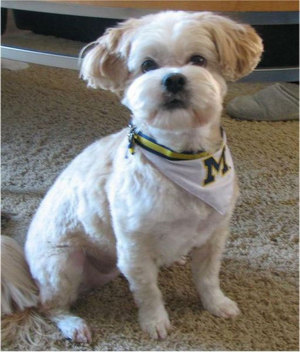Dry eye syndrome is a condition known as Keratoconjunctivitis Sicca (KCS). It is fairly common in lhasa apsos, Shih Tzu, American Cocker spaniel, Lhasa Apso, Pekingese, Pug, and West Highland Terrier. It is often caused by heredity running in bloodlines of certain dogs. Other causes of KCS include an autoimmune disorder, hypothyroidism, canine distemper, chronic conjunctivitis, facial nerve trauma, sulfa drugs and anesthesia.
I have to admit if my lhasa apso hadn’t had KCS, I never would have heard of the problem. Shaunnessey, my lhasa apso was continually getting into things and coming up with corneal abrasions (scratches on the eye). He’d rub his eye and we’d be back at the vet again. We tried patches, drops and keeping him on a limited activity schedule without luck.
Fortunately our veterinarian was affiliated with the University of Florida. The University of Florida is one of the veterinary centers studying the dry eye syndrome or the official name: Keratoconjunctivitis Sicca. Our veterinarian referred us to a canine opthamologist at the University of Florida. The opthamologist diagnosed Shaunnessey with KCS.
What are the symptoms?
Often the first signs you’ll notice is a mucous discharge in one or both of your lhasa apso’s eyes. Sometime there will be redness of the inside of the eyelid and rims of the eye. With the redness there is often itching and pain. Many lhasa apso owners first notice the eye problems when their dog keeps rubbing their eyes with the paw or on the rug.
How Is Dry Eye Syndrome Diagnosed?
Diagnosis is made by a physical examination of the dog and a test called the Schirmer tear test. With the Schirmer tear test, the amount of tears produced is recorded on a test strip. Lhasa apsos with KCS will have a low production of tears.
In addition the presence of a dry eye with mucous discharge coupled with the Schirmer tear test is used to diagnose Keratoconjunctivitis Sicca or KCS.
What Is The Treatment For KCS?
The downside of the dry eye syndrome, if left untreated leads to irreversible blindness. The goal of treatment is to keep the eye moist, and prevent infection and scarring of the cornea. The treatment can be done through a combination of medications and surgery. Often the initial treatment is to replace the lack of tear production with artificial tears and an antibiotic ointment to eliminate any infection present.
Occasionally the KCS will stop by itself. But most of the time the treatment must be continued for the life of the lhasa apso.
Other medications, which can be used for the treatment of KCS, include cyclosporin, steroids to decrease inflammation, and medications to decrease and thin the mucus production.
Surgical treatment can include moving the salivary duct from the mouth to the eye to keep the eye moist.
It is important in lhasa apsos with KCS that the hair around the eyes be kept trim and the face and eyes clean. This can prevent facial hair poking into the eye and causing further infection.
Shaunnessey has been on eye medication for 14 years after he was initially diagnosed with KCS. He has stayed active and has not lost his vision. With good veterinary follow up lhasa apsos are able to keep their vision. Success in treatment is also dependent on owners who are willing and able to keep up with the required medications and monitoring.
Dry Eye Syndrome In Lhasa Apsos
Dry eye syndrome is a condition known as Keratoconjunctivitis Sicca (KCS). http://en.wikipedia.org/wiki/Keratoconjunctivitis_sicca It is fairly common in lhasa apsos, Shih Tzu, American Cocker spaniel, Lhasa Apso, Pekingese, Pug, and West Highland Terrier. http://www.gopetsamerica.com/dog-health/dry-eye-syndrome.aspx It is often caused by heredity running in bloodlines of certain dogs. Other causes include an autoimmune disorder, hypothyroidism, canine distemper, chronic conjunctivitis, facial nerve trauma, sulfa drugs and anesthesia. http://www.gopetsamerica.com/dog-health/dry-eye-syndrome.aspx
I have to admit if my lhasa apso hadn’t had the problem, I never would have heard of the problem. Shaunnessey was continually getting into things and coming up with corneal abrasions (scratches on the eye). He’d rub his eye and we’d be back at the vet again. We tried patches, drops and keeping him on a limited activity schedule without luck.
Fortunately our veterinarian was affiliated with the University of Florida. The University of Florida is one of the veterinary centers studying the dry eye syndrome or the official name: Keratoconjunctivitis Sicca. The downside of the dry eye syndrome, if left untreated leads to irreversible blindness.
What are the symptoms?
Often the first signs you’ll notice is a mucous discharge in one or both of your lhasa apso’s eyes. Sometime there will be redness of the inside of the eyelid and rims of the eye. With the redness there is often itching and pain. Many lhasa apso owners first notice the eye problems when their dog keeps rubbing their eyes with the paw or on the rug.
How Is Dry Eye Syndrome Diagnosed?
Diagnosis is made by a physical examination of the dog and a test called the Schirmer tear test. With the Schirmer tear test, the amount of tears produced is recorded on a test strip. Lhasa apsos with KCS will have a low production of tears.
In addition the presence of a dry eye together with mucous discharge coupled with the Schirmer tear test is the combination used to diagnose Keratoconjunctivitis Sicca or KCS. http://www.animaleyecare.com/animalvision.html#kcs
What Is The Treatment For KCS?
The goal of treatment is to keep the eye moist, and prevent infection and scarring of the cornea. The treatment can be done through a combination of medications and surgery. Often the initial treatment is to replace the lack of tear production with artificial tears and an antibiotic ointment to eliminate any infection present.
Occasionally the KCS will stop by itself. But most of the time the treatment must be continued for the life of the lhasa apso.
Other medications, which can be used, include cyclosporin, steroids to decrease inflammation, and medications to decrease and thin the mucus production. http://www.animaleyecare.com/animalvision.html#kcs http://www.gopetsamerica.com/dog-health/dry-eye-syndrome.aspx
Surgical treatment can include moving the salivary duct from the mouth to the eye to keep the eye moist.
It is important in lhasa apsos with KCS that the hair around the eyes be kept trim and the face and eyes clean. This can prevent facial hair poking into the eye and causing further infection.
Shaunnessey was on eye medication for 14 years after he was initially diagnosed with KCS. He stayed active and did not lose his vision. With good veterinary follow up lhasa apsos are able to keep their vision as long as their owners are willing and able to keep up with the required medications and monitoring.







